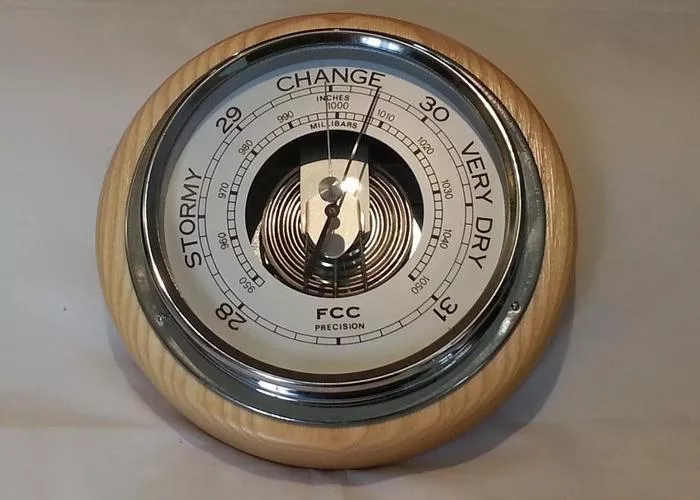A barometer is a device used to measure atmospheric pressure, one of the fundamental parameters in weather forecasting and environmental monitoring. By detecting changes in air pressure, barometers provide valuable insights into weather conditions, helping predict phenomena such as storms, rain, or fair weather. This article delves into the principles behind barometers, their construction, types, applications, and how they relate to meteorological science.
1. The Basics of Atmospheric Pressure
Atmospheric pressure is the force exerted by the weight of air in the Earth’s atmosphere. It is a result of the gravitational pull on the air molecules, which compresses the atmosphere near the Earth’s surface. Atmospheric pressure decreases with altitude due to the reduced density of air at higher elevations.
At sea level, the standard atmospheric pressure is approximately 1013.25 millibars (mb), or 29.92 inches of mercury (inHg). Barometers measure deviations from this baseline pressure, providing crucial information about the movement of air masses and weather patterns.
2. Working Principles of a Barometer
The operation of a barometer hinges on the principle of balancing the force exerted by atmospheric pressure against another measurable force, such as the weight of a liquid column or the elasticity of a metal diaphragm. When atmospheric pressure changes, the measurable force adjusts proportionally, enabling the barometer to provide a reading.
3. Types of Barometers and Their Mechanisms
Barometers come in various designs, each employing unique mechanisms to measure atmospheric pressure. The two most common types are mercury barometers and aneroid barometers.
Mercury Barometer
The mercury barometer, invented by Evangelista Torricelli in 1643, is the oldest type of barometer. Its construction is simple yet effective:
Design and Components:
A glass tube, sealed at one end and filled with mercury, is inverted into a reservoir of mercury.
The open end of the tube is submerged, creating a vacuum at the sealed end.
Atmospheric pressure pushes down on the mercury in the reservoir, forcing mercury up the tube.
Working Mechanism:
The height of the mercury column in the tube represents atmospheric pressure. Higher pressure pushes the mercury column higher, while lower pressure allows it to fall.
The column height is measured in units such as millimeters of mercury (mmHg) or inches of mercury (inHg).
Advantages:
High accuracy and sensitivity.
Provides consistent readings over time.
Disadvantages:
Bulky and fragile.
Mercury is toxic and poses environmental and health hazards.
Aneroid Barometer
The aneroid barometer was developed as a safer and more portable alternative to the mercury barometer. It uses mechanical components instead of liquid:
Design and Components:
Contains a sealed, flexible metal chamber called an aneroid cell.
The chamber is partially evacuated of air, causing it to expand or contract in response to changes in atmospheric pressure.
A system of levers and springs amplifies the chamber’s movements, which are then translated into a pressure reading on a calibrated dial.
Working Mechanism:
When atmospheric pressure increases, the aneroid cell compresses; when pressure decreases, it expands.
The mechanical linkage connected to the cell moves a needle or pointer on the dial, providing the pressure measurement.
Advantages:
Compact, portable, and durable.
Free of toxic materials.
Disadvantages:
Requires regular calibration to maintain accuracy.
Less precise than mercury barometers under certain conditions.
Digital Barometers
Modern technology has introduced digital barometers, which utilize sensors to measure atmospheric pressure electronically:
Design and Components:
- Equipped with piezoresistive or capacitive pressure sensors that detect changes in pressure.
- Outputs are displayed digitally and can be integrated into other devices, such as smartphones or weather stations.
Working Mechanism:
- Pressure sensors generate electrical signals proportional to the atmospheric pressure.
- A microprocessor converts the signals into readable units such as millibars or pascals.
Advantages:
- Highly accurate and precise.
- Can record data over time and transmit readings remotely.
Disadvantages:
- Dependent on power sources.
- Vulnerable to electronic malfunctions.
4. Applications of Barometers in Weather Forecasting
Barometers are indispensable tools in meteorology. They help forecasters understand atmospheric pressure trends, which are key indicators of weather changes:
High Pressure vs. Low Pressure:
- High-pressure systems typically bring clear skies and stable weather.
- Low-pressure systems are associated with clouds, precipitation, and storms.
Weather Prediction:
- A sudden drop in pressure often signals an approaching storm or cyclone.
- Gradual pressure changes can indicate shifting weather patterns.
Data Integration:
Barometers are part of weather stations, satellites, and aircraft systems, contributing to comprehensive weather models.
5. Barometers Beyond Weather Forecasting
While meteorology is the primary domain of barometers, they are also used in other fields:
Aviation:
Pilots rely on barometric readings to determine altitude and assess weather conditions during flights.
Scuba Diving:
Barometers aid in designing decompression tables by analyzing pressure variations underwater.
Geology:
Barometers measure pressure changes in volcanic environments to predict eruptions.
Environmental Studies:
Barometric data helps monitor air pressure’s impact on ecosystems and climate.
6. Challenges and Limitations of Barometers
Despite their utility, barometers face certain challenges:
Accuracy Concerns:
Environmental factors such as temperature, humidity, and altitude can affect readings.
Regular calibration is essential, particularly for aneroid and digital barometers.
Environmental Impact:
Mercury barometers pose risks due to the toxicity of mercury, necessitating careful handling and disposal.
Technological Reliance:
Digital barometers depend on power supplies and electronic components, which can fail.
Conclusion
Barometers are vital instruments for measuring atmospheric pressure, enabling accurate weather forecasting and aiding in various scientific and practical applications. From the elegance of mercury barometers to the precision of digital sensors, these devices continue to evolve, adapting to the demands of modern science and technology.
Understanding the working principles of barometers not only highlights their significance in meteorology but also underscores their broader role in aviation, environmental monitoring, and safety. By providing real-time pressure data, barometers help us interpret the dynamics of our atmosphere, empowering us to navigate and prepare for the ever-changing conditions of our planet.

